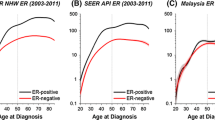Abstract
Background
Few studies have examined breast cancer hormone receptor expression in Africans. We report on the hormone receptor profile of breast cancer in East Africans in the largest prospective study for this region.
Methods
Consecutive breast cancer presentations to a hospital in Kijabe (2001–2007) were included. Demographic, clinical, and test data were collected. ER/PR and Her2 testing was based on immunohistochemistry (IHC).
Results
There were 129 subjects (median 47 years), most had invasive ductal cancer and locally advanced disease and/or metastases. ER/PR testing was done in 120: 24% had ER-positive tumours, 34% were ER- and/or PR-positive, 10% were ER-negative but PR-positive tumours, and 66% were negative for ER and PR. ER/PR positivity was not associated with stage (P = 0.28) and was not related to age, parity, menopausal status, or node metastases. Increasing tumour grade was associated with PR expression (P = 0.02) with decreasing frequency of PR positive tumours as histological grade increased; there was weak evidence of an association between grade and ER expression (P = 0.06). Of cases tested, 26.5% overexpressed Her2.
Conclusions
Breast cancer in Kijabe is an advanced-stage disease, comprised mainly of poorly differentiated cancers that are less likely to be hormone sensitive (across all stages of disease). ER/PR testing of all those affected by breast cancer should be supported as a global priority in cancer control. International and inter-African research collaborations are needed to allow genetic detailing of tumours in indigenous Africans to assess possible racial heterogeneity in the biology of breast cancer.
Similar content being viewed by others
References
Parkin DM, Bray F, Ferlay J, et al. Global cancer statistics, 2002. CA Cancer J Clin 2005; 55:74–108
Eniu A, Carlson RW, Aziz Z, et al. Breast cancer in limited-resource countries: treatment and allocation of resources. Breast J 2006; 12:S38–53
Nyagol J, Nyong’o A, Byakika B, et al. Routine assessment of hormonal receptor and her-2/neu status underscores the need for more therapeutic targets in Kenyan women with breast cancer. Anal Quant Cytol Histol 2006; 28:97–103
Ikpatt OF, Ndoma-Egba R. Oestrogen and progesterone receptors in Nigerian breast cancer: relationship to tumour histology and survival of patients. Cent Afr J Med 2003; 49:122–6
Mbonde MP, Amir H, Schwartz-Albiez R, et al. Expression of estrogen and progesterone receptors in carcinomas of the female breast in Tanzania. Oncol Rep 2000; 7:277–83
Anderson BO, Shyyan R, Eniu A, et al. Breast cancer in limited-resource countries: an overview of the Breast Health Global Initiative 2005 guidelines. Breast J 2006; 12:S3–15
Henson DE, Chu KC, Levine PH. Histological grade, stage and survival in breast carcinoma. Comparison of African American and Caucasian women. Cancer 2003; 98:908–17
International Agency for Research on Cancer (IARC): GLOBOCAN 2002 database (accessed 03/01/2008): http://www-dep.iarc.fr
Fregene A, Newman LA. Breast cancer in sub-Saharan Africa: How does it relate to breast cancer in African-American women? Cancer 2005; 103:1540–50
Chu KC, Anderson WF. Rates for breast cancer characteristics by oestrogen and progesterone receptor status in the major racial/ethnic groups. Breast Cancer Res Treat 2002; 74:199–211
Chu KC, Anderson WF, Fritz A, et al. Frequency distributions of breast cancer characteristics classified by estrogen receptor and progesterone receptor status for eight racial/ethnic groups. Cancer 2001; 92:37–45
Siziopikou KP, Cobleigh M. The basal subtype of breast carcinomas may represent the group of breast tumours that could benefit from EGFR-targeted therapies. Breast 2007; 16:104–7
Carey LA, Perou CM, Livasy CA, et al. Race, breast cancer subtypes, and survival in the Carolina Breast Cancer Study. JAMA 2006; 295:2492–502
Acknowledgements
We acknowledge the generosity of individuals who provided donations to support hormone receptor testing of subjects in this study. We thank Professor Mark Pegram (University of Miami) for providing comments on an earlier draft of this paper and Ms Siew Chan (University of Sydney) for assistance with analyses. Dr Houssami is supported by National Health and Medical Research Council (NHMRC) program grant no. 402764 to the Screening & Test Evaluation Program.
Author information
Authors and Affiliations
Corresponding author
Rights and permissions
About this article
Cite this article
Bird, P.A., Hill, A.G. & Houssami, N. Poor Hormone Receptor Expression in East African Breast Cancer: Evidence of a Biologically Different Disease?. Ann Surg Oncol 15, 1983–1988 (2008). https://doi.org/10.1245/s10434-008-9900-7
Received:
Revised:
Accepted:
Published:
Issue Date:
DOI: https://doi.org/10.1245/s10434-008-9900-7




